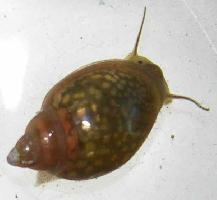
Poids et mesures
| Longueur | de 1 à 2 cm |
|---|
Description de l'animal
The European physa, scientifically known as Physella acuta, is a species of small, freshwater snail that is part of the family Physidae. These snails are also commonly referred to as the acute bladder snail due to their distinctive, pointed shell shape. Originally native to Europe, Physella acuta has now been widely introduced and has established itself in many parts of the world, making it a cosmopolitan species.Physella acuta typically has a shell that reaches up to 15 mm in length, although most individuals are smaller. The shell is characterized by its sinistral coiling, meaning it spirals to the left, which is a distinctive feature of the family Physidae. This left-handed coiling is a reverse of the more common right-handed coiling seen in most other snail species. The shell is elongated and comes to a pronounced, acute point at its apex, hence the name "acute." It is thin but sturdy, with a translucent quality that sometimes allows the internal organs or the snail's pigmentation to be seen through the shell.
The color of the shell can vary from light brown to almost transparent, with some snails displaying darker brown bands or spots. The body of the snail is usually a dark grey or black, providing a stark contrast to the lighter shell. Physella acuta has a relatively large aperture, or opening, which is also sinistral and lacks an operculum, the hard protective cover that some other snail species have.
One of the most interesting features of the European physa is its ability to breathe both through gills and a lung, an adaptation known as amphibious respiration. This allows it to survive in varying aquatic conditions, including poorly oxygenated waters where other snails might not thrive. It surfaces to the water to gulp air into its lung, which is then used for respiration when submerged.
The snail is known for its high reproductive rate and ability to quickly populate new habitats. It is hermaphroditic, meaning each individual possesses both male and female reproductive organs. This allows for a flexible mating strategy, where snails can either self-fertilize or cross-fertilize with another snail. Eggs are laid in small gelatinous clutches, often on the underside of leaves or other surfaces, and can hatch within a few weeks, depending on the environmental conditions.
Physella acuta feeds primarily on detritus, algae, and decomposing plant material, playing an important role in the aquatic ecosystem by contributing to the breakdown of organic matter. However, in some environments where it has been introduced, it can become a pest, outcompeting native species and altering the local ecosystem balance.
In terms of habitat, the European physa is highly adaptable and can be found in a wide range of freshwater environments, including rivers, streams, lakes, ponds, and even ditches. It tends to prefer slow-moving or stagnant waters with plenty of vegetation. The snail's ability to tolerate various levels of water quality and its generalist feeding habits have contributed to its success as an invasive species in many regions outside its native range.
Overall, the European physa (Physella acuta) is a small but highly adaptable freshwater snail with a distinctive shell and reproductive strategy that has allowed it to become one of the most widespread and successful freshwater snail species globally.
Nouvelles photos d'animaux
Top 10 des animaux
- Dolphin gull (Leucophaeus scoresbii)
- Diana monkey (Cercopithecus diana)
- Moustached guenon (Cercopithecus cephus)
- Galápagos tortoise (Geochelone nigra complex)
- Russian tortoise (Testudo horsfieldii)
- Japanese macaque (Macaca fuscata)
- Stone loach (Barbatula barbatula)
- Common flying dragon (Draco volans)
- Greek tortoise (Testudo graeca)
- Vendace (Coregonus albula)